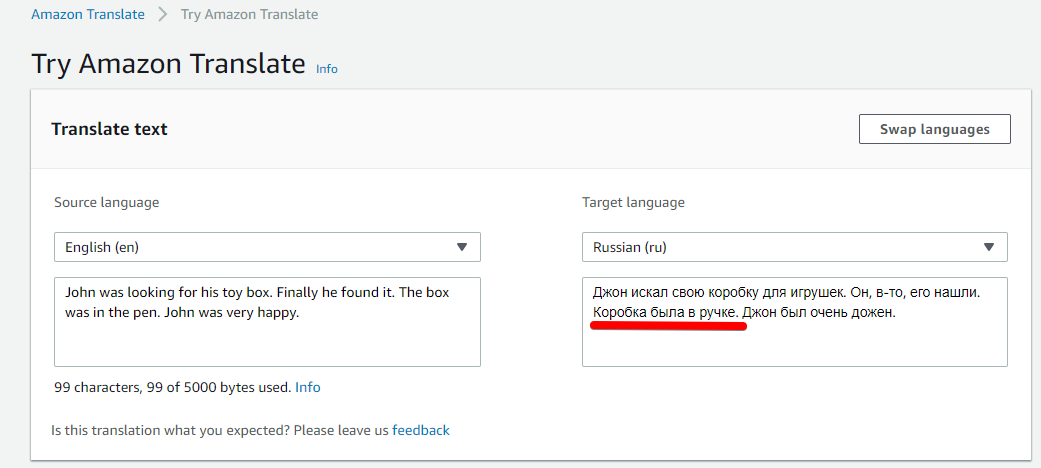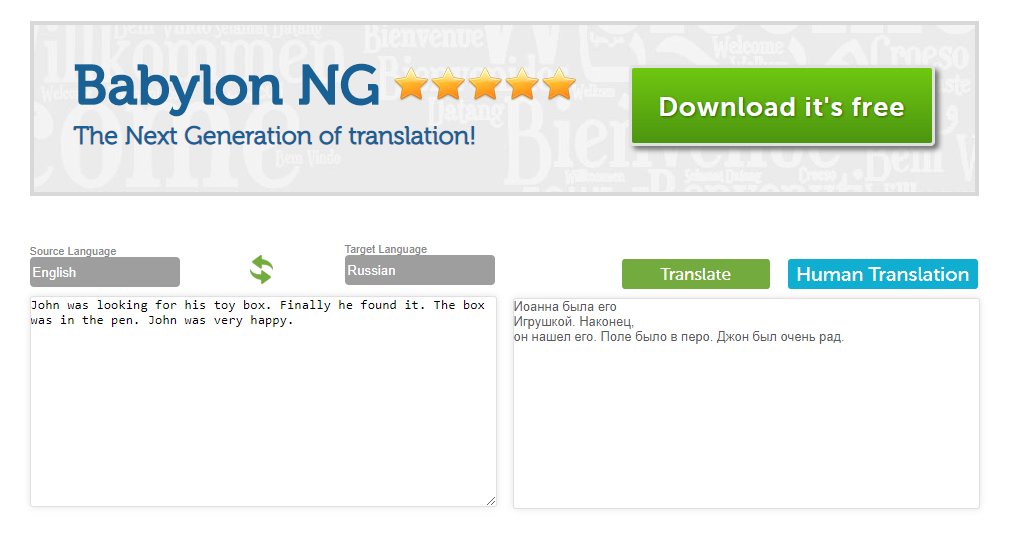The box is still in the pen: why in 2018 you still need to learn languages yourself
In 1959, one of the leading linguists and mathematicians of the time, Joshua Bar-Hillel , published a famous article: “Demonstration of the impossibility of fully automatic high-quality machine translation” [1]. Since then, the ghost of the boy Johnny, who left a box with toys in the arena, as the Nazgl should be on the heels of dreamers who do not spare investors' money to search for the Babylonian fish . Almost 60 years have passed - a lifetime (and at least four for computer technologies), but Johnny is still there: breathing in the back of deep-hole neural networks, does not allow hadoop clusters to relax.

In 2018, the correct translation of the text “John was looking for his toy box. Finally he found it. The box was in the pen. John was very happy is just as inaccessible to electronic brains as in 1959. Bara-Hillel’s thesis was that no fully automatic machine translation system could ever correctly determine the meaning of the word pen (playpen) in this context, although it is quite obvious to humans. As our mini-study has shown, despite the great progress in the development of the cumulative artificial intelligence of mankind, achieved in the last five years, it has not lost its relevance.
John was looking for his toy box. Finally he found it. The box was in a pen. John was very pleased.
')

John was looking for his box of toys. Finally, he found it. The box was in a pen. John was very happy.

John was looking for his toy box. Finally he ours his. The box was in a pen. John was very happy.

John was looking for his toy box. He, in fact, found him. The box was in a pen. John was very dear.

John was looking for his toy box. He finally found it. The box was in a pen. John was very happy.

John was his toy. Finally, he found it. The field was in a feather. John was very happy.

As you can see, five of the six tested automatic translation systems fully agree that the box was in a pen. The old Babylon turned out to be more creative than the others: having reported that John was his toy, he apparently suspected a trick, and suggested that "the field was in a feather." Amazon Translate - a neural machine translation service that provides fast, high-quality and affordable translation from one language to another (quoted from the manufacturer's website) - was pleased with the neologism “dozhen” (happy) and the phrase “he, in fact, found him ". Epic "he found it" against the background of these achievements looks even somehow ordinary.
Therefore, our conclusions will not differ much from those of Professor Bar-Hillel, and the recommendations will not differ much from the recommendations formulated in 1966 in the “Language and Machines” report of the Advisory Committee on Automatic Processing of Natural Languages (ALPAC) at the National Academy of Sciences of the USA [2]. It advised not to spend taxpayers' money on unrealistic projects, but at the same time emphasized the potential usefulness of computer translation technologies as a source of supporting background information for people.
Never, never, never rely entirely on machine translation. To the maximum, use the capabilities of modern electronic systems to search for translation options in context. At the moment, there are many free online dictionaries available in different languages, a contextual search for examples of usage - just imagine how you would do it without a computer in the library!
Make the most of the opportunities provided by electronic simulators: to listen, to form a vocabulary, to consolidate an understanding of various grammatical structures.
And, most importantly, do not experience illusions. As before, to learn how to understand a written text or a speech in another language, you will have to make a lot of effort. Your advantage is that in 2018 you have a lot of stupid, but diligent and quick electronic assistants.
Always yours, Puzzle English
[1] “A demonstration of the non-feasibility of fully-automatic high-quality machine translation”; Appendix IV of the United States and Great Britain. ' Hebrew University, Jerusalem, Israel, February 1959; 6pp.
[2] “Language and machines: computers in translation and linguistics”. A report on the Automatic Language Processing Advisory Committee, Division of Behavioral Sciences, National Academy of Sciences, National Research Council. (Washington, DC: National Academy of Sciences - National Research Council, 1966)

In 2018, the correct translation of the text “John was looking for his toy box. Finally he found it. The box was in the pen. John was very happy is just as inaccessible to electronic brains as in 1959. Bara-Hillel’s thesis was that no fully automatic machine translation system could ever correctly determine the meaning of the word pen (playpen) in this context, although it is quite obvious to humans. As our mini-study has shown, despite the great progress in the development of the cumulative artificial intelligence of mankind, achieved in the last five years, it has not lost its relevance.
Google translate
John was looking for his toy box. Finally he found it. The box was in a pen. John was very pleased.
')

Microsoft Translator
John was looking for his box of toys. Finally, he found it. The box was in a pen. John was very happy.

Promt online
John was looking for his toy box. Finally he ours his. The box was in a pen. John was very happy.

Amazon translate
John was looking for his toy box. He, in fact, found him. The box was in a pen. John was very dear.

Yandex translator
John was looking for his toy box. He finally found it. The box was in a pen. John was very happy.

Babylon translation
John was his toy. Finally, he found it. The field was in a feather. John was very happy.

As you can see, five of the six tested automatic translation systems fully agree that the box was in a pen. The old Babylon turned out to be more creative than the others: having reported that John was his toy, he apparently suspected a trick, and suggested that "the field was in a feather." Amazon Translate - a neural machine translation service that provides fast, high-quality and affordable translation from one language to another (quoted from the manufacturer's website) - was pleased with the neologism “dozhen” (happy) and the phrase “he, in fact, found him ". Epic "he found it" against the background of these achievements looks even somehow ordinary.
But there are pluses:
- since it is difficult to assume that the developers did not know about the existence of this challenge, it is worth noting their absolute professional integrity. No one is hardcoded!
- the general meaning of what is happening can almost always be restored by the brain of the average Russian-speaking homo sapiens, and even with the presence of “he was, in fact, found him” and the mysterious “dozhen”. The strange story of Joanna and those who suddenly found John is rather an exception, confirming the rule.
Therefore, our conclusions will not differ much from those of Professor Bar-Hillel, and the recommendations will not differ much from the recommendations formulated in 1966 in the “Language and Machines” report of the Advisory Committee on Automatic Processing of Natural Languages (ALPAC) at the National Academy of Sciences of the USA [2]. It advised not to spend taxpayers' money on unrealistic projects, but at the same time emphasized the potential usefulness of computer translation technologies as a source of supporting background information for people.
Never, never, never rely entirely on machine translation. To the maximum, use the capabilities of modern electronic systems to search for translation options in context. At the moment, there are many free online dictionaries available in different languages, a contextual search for examples of usage - just imagine how you would do it without a computer in the library!
Make the most of the opportunities provided by electronic simulators: to listen, to form a vocabulary, to consolidate an understanding of various grammatical structures.
And, most importantly, do not experience illusions. As before, to learn how to understand a written text or a speech in another language, you will have to make a lot of effort. Your advantage is that in 2018 you have a lot of stupid, but diligent and quick electronic assistants.
Always yours, Puzzle English
[1] “A demonstration of the non-feasibility of fully-automatic high-quality machine translation”; Appendix IV of the United States and Great Britain. ' Hebrew University, Jerusalem, Israel, February 1959; 6pp.
[2] “Language and machines: computers in translation and linguistics”. A report on the Automatic Language Processing Advisory Committee, Division of Behavioral Sciences, National Academy of Sciences, National Research Council. (Washington, DC: National Academy of Sciences - National Research Council, 1966)
Source: https://habr.com/ru/post/420739/
All Articles